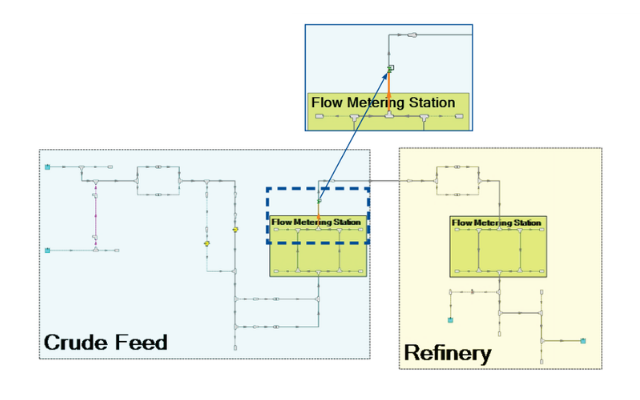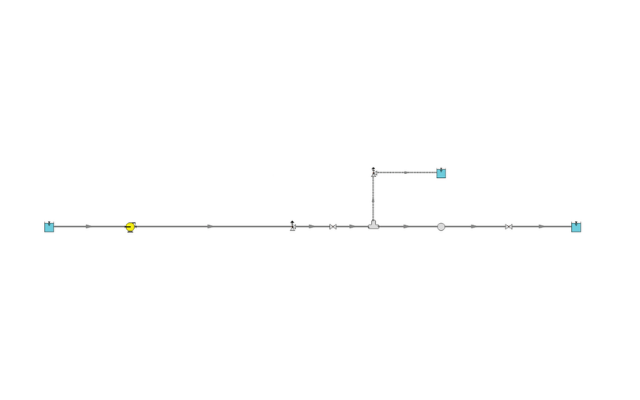Bernard Muller, Principal Process Engineer with MegChem, was asked to help a client with an upgrade to a tank farm where an existing 120 km (75 mi) pipeline transported crude from storage tanks to a refinery. As part of the upgrade, Motor Operated Valves (MOVs) were installed on the destination storage tank inlets to assist with overfill protection. The closure of these control valves could cause pressure surge.
Any resulting damage from the valve closure pressure surge would be compounded by an increased maximum design flow, caused by dosing the crude with a Drag Reducing Agent (DRA). To protect the pipeline against surge pressures due to these system changes, the MOV close times had to be carefully designed to avoid exceeding pipe pressure limits under any circumstance. Initially, Muller used conventional conservative surge calculations resulting in impractically long MOV closure times. He decided to model the crude transfer system in AFT Fathom and AFT Impulse in order to more accurately design the MOV closing time (Figure 1), as well as to design any additional measures if required to protect the system against overpressure.
Through the analysis, he found the closing time should be at least 150 seconds to prevent excessive pressure surges. The more precise AFT calculations, ratherthan conventional surge calculations, enabled him to confidently design the system with a less conservative valve closure.
Modeling the system with AFT software allowed him to perform various other studies in addition to the surge evaluation such as:
- Deducing an uncertain pump impeller size by comparing AFT Fathom simulated results with the actual measured flowrate.
- Accounting for a DRA which inhibits flow turbulence formation, lowering the losses in the pipeline to increase maximum flow. In the model, pipe design factors were adjusted to meet a measured flowrate.
Using AFT Fathom, Muller was also able to identify that the Pressure Safety Valve (PSV) at the end of the pipeline was too small for the increased design flow (Figure 2). Although this PSV was not part of the initial investigation, using AFT Fathom, this potential flaw in the design was uncovered and rectified. Using too small of a PSV could have resulted in a catastrophic event such as a pipe rupture, loss of containments, or even a fire.

Figure 2: AFT Fathom Workspace view identifying the Pressure Safety Valve (PSV) between the crude feed to the refinery. AFT Fathom helped recognize a PSV was too small, which could have resulted in a catastrophic event such as a pipe rupture, loss of containments, or even a fire.
Downstream of the PSV is a pressure control valve, whose behavior was modeled using transient event sets. This control valve improved the realism of the analysis to inform control valve set pressures. This analysis was similarly applied for transferring slop (a refinery waste stream) to the tank as opposed to crude when determining the appropriate slop closure time.
MegChem is an engineering and projects company operating in the oil, gas, power generation, petrochemical and related industries. They are able to translate an undefined failure into a design solution that can be contracted out within the framework of different commercial models.
It was further shown, from an overpressure point of view, the crude transfer pumps must be tripped when the MOVs are closed. This assisted with developing the appropriate overpressure protection control philosophy. Despite very little information on the crude pumps being available, the spin-down of the tripped pump could easily be simulated using the built-in inertia estimator in AFT Impulse.
Finally, the surge analyses identified several existing pipelines that had to be rerated for a higher design pressure, largely due to the higher design flow. While rerating did not require any physical changes, it ensured future discrepancies/audit findings regarding pipeline design pressure exceedances are avoided.
AFT Fathom and AFT Impulse saved MegChem a substantial amount of research and design time due to AFT software’s versatile features. With the complexity of the model, performing the analysis using hand calculations was not feasible. AFT Fathom and AFT Impulse allowed them to quickly perform the analysis within the extremely short project timeline while avoiding excessively conservative designs.
Muller most appreciated AFT Impulse’s graphing tools (especially the time-based graphs). He found it extremely useful for visualizing the system response and for explaining the predicted behavior to the client or other engineering disciplines involved in the project.




